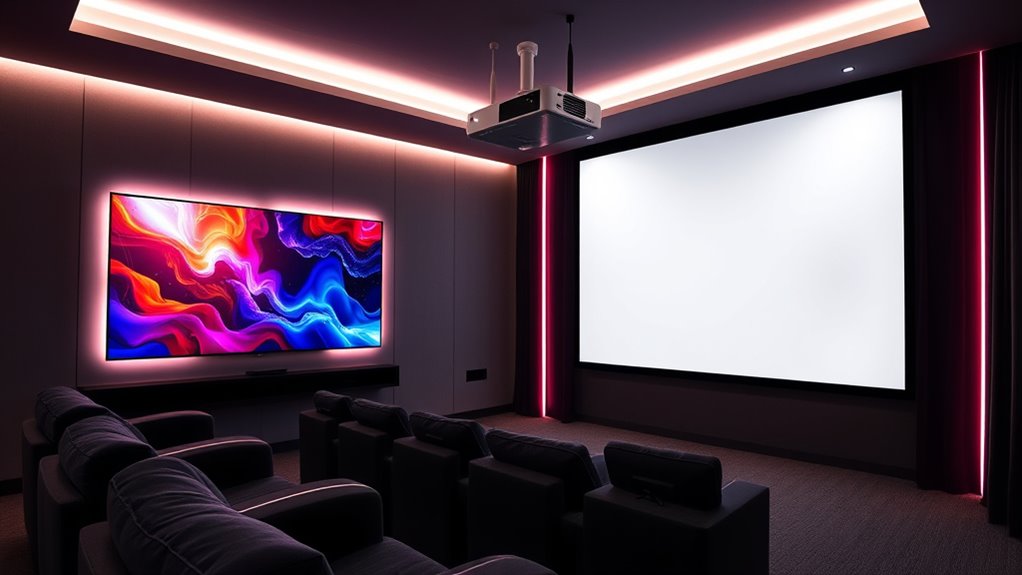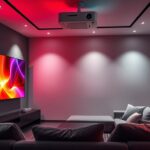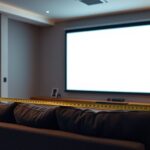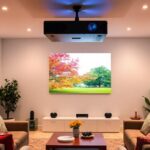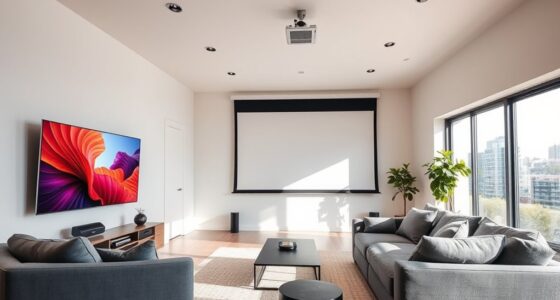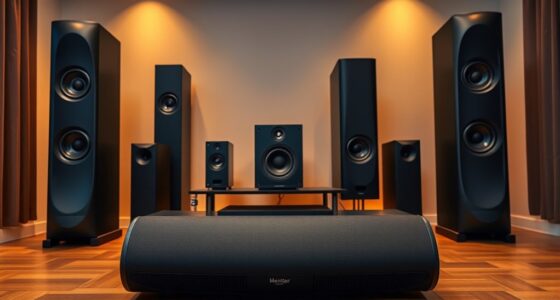Choosing between a projector and a TV depends on your room size, lighting conditions, and budget. Projectors offer large, immersive images ideal for dark rooms, but they need space and occasional maintenance. TVs are more convenient, perform well in bright environments, and have smart features. If you’re after a big, theater-like experience and have the right setup, a projector could be your best pick. Want to discover which option suits your needs best? Keep exploring to find out more.
Key Takeaways
- Consider room lighting; projectors need dark environments, while TVs perform well in bright spaces.
- Large screen size and immersion favor projectors; smaller, convenient screens suit TVs.
- Budget impacts choice; high-quality projectors and screens can be costly compared to premium TVs.
- Maintenance differs: projectors require bulb replacements, while TVs are more hassle-free over time.
- Personal preferences for setup ease, image size, and environment determine whether a projector or TV is best.

Choosing the right display for your home theater can considerably enhance your viewing experience. When deciding between a projector and a TV, you need to consider several factors that influence how you’ll enjoy your movies, shows, and gaming sessions. Your room size, lighting conditions, budget, and personal preferences all play vital roles in making the best choice.
If you’re leaning toward a projector, you’re opting for a larger, often more cinematic image. Projectors excel in creating a theater-like atmosphere, especially in rooms with controllable lighting. If your space is spacious and you can darken the room effectively, a projector can give you a massive screen—sometimes up to 120 inches or more—at a fraction of the cost of a similarly sized TV. This makes projectors ideal if you crave an immersive experience or have a dedicated home theater room. However, keep in mind that projectors generally require more maintenance; you’ll need to replace bulbs periodically, and image quality can be affected by ambient light, making them less suitable for brightly lit spaces. Additionally, as technology advances, some projectors now incorporate advanced image processing features that improve picture quality even in less-than-ideal conditions. Moreover, choosing the right screen type can significantly influence the projected image’s clarity and brightness, especially in varying room environments. To optimize your projector setup, consider investing in ambient light rejection screens, which can enhance image quality in brighter rooms. Additionally, many projectors now offer wireless connectivity, allowing for easier streaming and setup without cumbersome cables.
On the other hand, a TV offers instant convenience and excellent picture quality without much fuss. Modern LED and OLED TVs deliver sharp images with vibrant colors, deep blacks, and high contrast ratios, even in well-lit rooms. If you prefer a straightforward setup with minimal adjustments, a TV is your best bet. They also tend to be more reliable over time, with no bulbs to replace, and they support smart features, apps, and connectivity options that enhance your viewing experience. Additionally, the compact size of TVs allows for flexible placement, whether mounted on a wall or placed on a stand, fitting seamlessly into various room layouts.
Price is another significant factor. High-end projectors and screens can be costly, especially when factoring in a quality sound system. Conversely, a premium TV might cost less than a large projector setup but still provide excellent image quality and convenience. Think about your budget and what kind of investment you’re willing to make.
Furthermore, advancements in sound and image technology continue to bridge the gap between projectors and TVs, offering more options tailored to different preferences. Ultimately, your choice depends on what you prioritize most: If you want a colossal image and are willing to invest in a controlled lighting environment, a projector might be the perfect fit. If you prefer quick setup, consistent picture quality in various lighting conditions, and less maintenance, a TV is likely the better choice. Both options can deliver spectacular home theater experiences, so consider your space, budget, and viewing habits carefully to make the best decision for your home.
Frequently Asked Questions
What Is the Average Lifespan of Projectors Versus TVS?
When comparing lifespan, you’ll find that projectors typically last around 7,000 to 10,000 hours, which can translate to several years of regular use. TVs, especially LED and OLED models, usually last about 50,000 to 100,000 hours before their brightness and picture quality decline noticeably. So, if you want longevity, a TV might be the better choice, but projectors can offer a longer-term investment if maintained properly.
How Much Space Is Needed for a Projector Setup?
You might think a small space limits your options, but a projector needs about 10-15 feet of distance from the screen for clear images, depending on the model’s throw ratio. While TVs fit easily on a wall, projectors require a dedicated area with enough room for the projector and screen. Consider your room’s size and layout, ensuring you have enough space to enjoy a cinematic experience without crowding.
Which Option Offers Better Motion Handling for Sports?
When it comes to motion handling for sports, you want a display that minimizes blur and provides smooth visuals. TVs generally excel in this area because they have faster refresh rates and motion interpolation technologies. Projectors, on the other hand, might struggle with fast-moving action due to slower response times. So, if crisp, clear motion is your priority for sports, a high-quality TV is the better choice.
Are There Any Health Concerns With Long-Term TV or Projector Use?
While long-term use of TVs or projectors generally doesn’t pose serious health risks, it’s smart to take precautions. You might experience eye strain or fatigue if you watch for extended periods without breaks. Make certain proper lighting and maintain a comfortable viewing distance. Adjust brightness and contrast to avoid glare. Taking regular breaks and practicing good posture can help reduce potential strain, making your viewing experience healthier and more enjoyable.
How Do Lighting Conditions Affect the Viewing Experience?
Lighting conditions profoundly impact your viewing experience. Bright rooms can wash out images, making details hard to see, while dim or dark environments enhance contrast and color vibrancy. You should adjust your room’s lighting to suit your display type; for example, minimize ambient light for projectors and control glare with curtains or dimmable lights. Proper lighting ensures you enjoy clear, vivid visuals without straining your eyes or losing image quality.
Conclusion
Choosing between a projector and a TV is like picking a partner for your home theater adventure. I once set up a projector in my basement, and the experience felt like stepping into a private cinema—immense screen, immersive sound. Remember, the right display depends on your space, budget, and preferences. Whichever you choose, make it your own special spot where movies become unforgettable stories. Your perfect home theater awaits—just pick what feels right for you.
